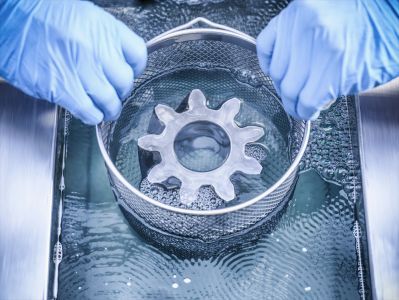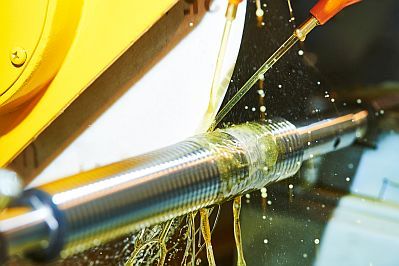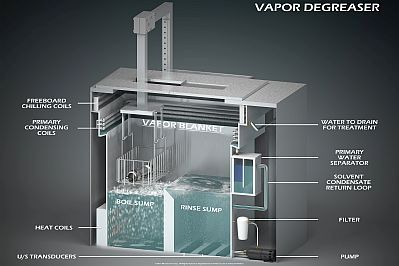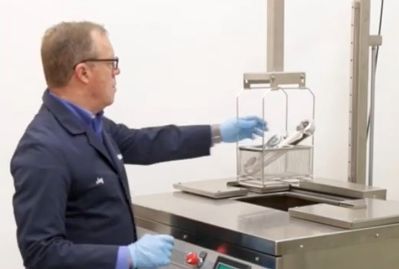Planning Your Cleaning Process Shouldn't Give You the Vapors! (Or Should It?)
The key to achieving high-quality surface finishes lies in effective cleaning processes. Contaminants like grease, stamping or cooling oils, dust, metal filings and fingerprints must be removed from parts to ensure successful downstream finishing processes, like plating, coating, painting, or welding, are achieved. Elizabeth Norwood, Senior Chemist at MicroCare, LLC, explains why she thinks vapor degreasing may be the best cleaning method for your shop. (Watch Videos)

Contaminants like grease, stamping or cooling oils, dust, metal filings and fingerprints must be removed from parts to ensure successful downstream finishing process.
Careful planning of cleaning procedures is essential before any metal finishing processes take place and for parts to pass quality and validation inspections. Proper planning sets the foundation for successful surface finishes by ensuring every production and finishing step is meticulously thought out and executed. This is especially crucial in industrial settings, where precision and consistency are paramount. Planning involves:
- Assessing the material composition.
- Understanding contaminants present.
- Evaluating cleanliness specifications.
- Determining appropriate cleaning methods and fluids to achieve an optimal finish.
By undertaking comprehensive planning, manufacturers can identify potential challenges and tailor their cleaning and finishing processes accordingly. Proper planning also ensures that the right cleaning equipment and fluid are selected, minimizing the risk of costly mistakes and rework.
Understanding Vapor Degreasing
Among the various cleaning methods available, vapor degreasing is considered a highly effective and preferred choice for critical cleaning in production and metal finishing. Its exceptional performance, cost-effectiveness, and flexibility make it a popular solution for many cleaning needs.
VIDEO: Vapor Degreasing Explained: What It Is and How It Works
Vapor degreasing uses a two-sump system that ensures thorough cleaning, rinsing, and drying of parts. The cleaning fluid is heated to produce vapor, which rises from the boil sump, condenses on cooler parts, and dissolves and lifts contaminants. The parts are then transferred to the rinse sump and rinsed in pure, uncontaminated fluid or inside the vapors. The components come out cool to the touch, so they are immediately ready for use or the next step in the processing.
Vapor degreasing and modern cleaning fluids offer several advantages for critical cleaning in production and metal finishing processes.

Vapor degreasing's cost-effectiveness, and flexibility make it a popular solution for many cleaning needs.
Thorough and Efficient Cleaning: Vapor degreasing cleaning fluids combine high densities, low surface tensions and low viscosities to completely dissolve contaminants and remove particulate from small intricate parts with complex geometries to ensure comprehensive cleaning that is difficult to achieve with other methods.
Quick Turnaround Times: The fast and efficient cleaning process enables high throughput, reducing production lead times and increasing productivity. Parts can be quickly cleaned and moved through subsequent finishing processes.
Environmentally Friendly and Safe Option: Vapor degreasing is an eco-friendly option when used with modern cleaning fluids. Based on HFO (Hydrofluoroolefin) technology, they boast zero Ozone Depleting Potentials (ODP) and low Global Warming Potentials (GWP), reducing air quality concerns. They are not hazardous air pollutants (HAP) and do not require National Emission Standards for Hazardous Air Pollutants (NESHAP) permits. Effectively managed vapor degreasing systems also have minimal impact on the environment.
Cost-Effectiveness: Vapor degreasing is cost-effective due to its efficient use of cleaning fluid and reduced waste generation. The cleaning fluid can be recycled and reused many hundreds of times, reducing overall cleaning costs.
Consistent and Repeatable: Vapor degreasers' versatility in accommodating various batch sizes and part geometries ensures stable and repeatable cleaning results, eliminating the need for equipment updates for new products of varied sizes or materials. This simplifies validation requirements through a consistent and auditable cleaning process record.
Selecting the Right Cleaning Fluid and Equipment
The success of any cleaning process relies on thorough planning which includes selecting the appropriate cleaning fluid and equipment. Several factors must be carefully considered, such as the type of contaminant to be removed, cleanliness specifications, material composition, and the volume of parts to be cleaned. Rushing into an investment without thoughtful evaluation can lead to costly mistakes, such as using equipment that cannot handle specific contaminants.

Selecting the appropriate cleaning fluid is crucial in achieving optimal cleaning performance and ensuring the safety and compatibility of the parts being cleaned.
Choosing the correct cleaning fluid is crucial. Striking the right balance between the fluid's strength to remove the contaminant and preventing damage to parts materials is vital. Vapor degreasing can be categorized into three main types: mono-solvent, co-solvent, and bi-solvent cleaning. To determine the most suitable process, it is important to understand the specific contamination, part characteristics, and time limitations. Undertaking cleaning trials is essential to ensure they meet the required cleanliness level.
Mono-solvent
Mono-solvent consists of a single cleaning fluid. They are strong and high-boiling, making them effective in removing hydrocarbon-based contaminants, such as stamping oils, machining lubricants, corrosion protection agents, and metal shavings. They can also melt waxes off metal parts.
Some are designed as azeotropes and made with two or more components that form a stable mixture when combined. These azeotropes have the advantage of behaving as a single solvent during boiling, cooling, and distillation. They are typically engineered to render cleaning fluids nonflammable, to enhance their cleaning performance or to improve their toxicity profile. They provide the cleaning performance and safety of a mixture of cleaning solvents, but with the easy storage, handling, and disposal of a single or mono-solvent cleaning fluid.
Co-solvent
Co-solvent cleaning takes the efficacy of mono-solvent cleaning to the next level by combining two solvents. One solvent boils at a very high temperature, while the other boils at a much lower temperature. This combination enhances the overall cleaning performance, making co-solvent cleaning highly effective against a broader range of contaminants.

Comprehensive planning of cleaning procedures and selecting the appropriate cleaning fluid are key to achieving a high-quality finish.
The high-temperature, non-volatile solvating agent dissolves stubborn or more difficult soils, including solder fluxes, silicone oils, synthetic greases, grinding media, polishing pastes, baked-on resins, and inks. This fluid has strong solvating capabilities, breaking down and lifting tough contaminants from the surface of the parts.
The low-boiling, volatile rinsing agent complements the solvating agent by washing it off the components and providing the vapor blanket for additional cleaning and drying. The combination of these two solvents ensures thorough cleaning and leaves the parts spotless, ready for subsequent finishing processes.
Bi-solvent Cleaning Fluids
For the most stubborn soils, such as thick waxes, heavy pitches, and viscous metal working fluids, bi-solvent cleaning offers an effective solution. Bi-solvent cleaning involves a two-sump vapor degreaser and a separate preliminary cleaning tank. The solvating agent is placed in the separate cleaning tank outside the vapor degreaser, and it operates at much higher temperatures than the rinse agent in the rinsing sumps inside the vapor degreaser itself.
The bi-solvent cleaning process starts by immersing the parts in the preliminary cleaning tank containing the high-temperature solvating agent. This agent dissolves or solubilizes the stubborn contaminants, breaking them down for easy removal. The parts are then transferred to the rinse sump, where the rinsing agent removes the solvating agent and loosens, lifts, and washes away any residual contamination.

Using a co-solvent or bisolvent that is too powerful for the contaminant, or the substrate can damage parts.
Although co-solvent and bi-solvent cleaning have advantages, it is essential to proceed cautiously. These methods should be reserved for only the most difficult-to-remove soils. Not all parts require these more aggressive, high-temperature cleaning techniques. Using a co-solvent or bisolvent that is too powerful for the contaminant, or the substrate can damage parts.
Choosing the Right Cleaning Fluid
Selecting the appropriate cleaning fluid is crucial in achieving optimal cleaning performance and ensuring the safety and compatibility of the parts being cleaned. When choosing a cleaning fluid, there are several key factors that should be taken into consideration during the planning stage:
- Type of Contaminant: The vapor degreasing fluid should be compatible with the type of contaminants present on the parts. For example, non-polar contaminants like oils and greases are best removed with non-polar cleaning fluids, while polar contaminants like emulsion residue and graphite may require different cleaning methods.
Material Composition: The cleaning fluid must be compatible with the material of the parts being cleaned to avoid damage or degradation.
Cleaning Performance: The cleaning fluid should have the necessary strength and solvating capabilities to remove the specific contaminants effectively.
Environmental and Safety Considerations: Use environmentally friendly cleaning fluids, such as non-chlorinated and low-VOC solvents, to align with sustainability goals. Importantly use a cleaning solution that is safe to workers.
VIDEO: How To Be Environmentally-Friendly in Parts Cleaning
By carefully evaluating these factors and conducting cleaning trials with contaminated sample parts, manufacturers can confidently select the most suitable cleaning fluid for their specific application, ensuring optimal cleaning results and impeccable surface finishes.
Perfect Results
Surface finishes free of contaminants are important to ensure optimal functionality and performance. Comprehensive planning of cleaning procedures and selecting the appropriate cleaning fluid are key to achieving a high-quality finish.
Vapor degreasing offers an efficient, cost-effective, safe, and environmentally friendly option for critical cleaning. However, the cleaning fluid and equipment must be carefully matched to the contaminant type and material composition to prevent damage. With proper planning and evaluation, manufacturers can develop optimized vapor degreasing processes that deliver repeatable, validated results and enable the production of spotless metal parts.
Want more information? Click below.
Rate this article
View our terms of use and privacy policy